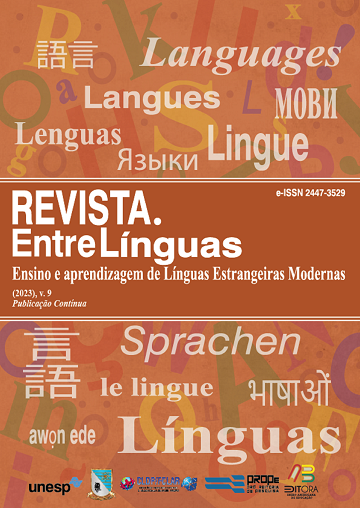Una imagen ingenua del mundo y un enfoque biosemántico para describir la estructura léxica de una palabra
DOI:
https://doi.org/10.29051/el.v9i00.17640Palabras clave:
Biosemiótica, Significado, Polisemia, Lingüística cognitive, Invariante léxicaResumen
Los problemas de estudiar la estructura léxica de una palabra tienen salida en varias áreas de la ciencia cognitiva, incluida la biosemiótica. En el artículo, el enfoque biosemiótico se reformula en un enfoque biosemántico basado en la decodificación de estructuras léxicas específicas. Se muestra que las invariantes léxicas de las palabras polisémicas son núcleos significativos de sus significados figurativos. Es un conjunto de componentes semánticos dominantes que se asocian de manera estable con cada significado de lexema. En el proceso de semiosis, el individuo se guía por estos componentes invariantes. Estos componentes se forman con el tiempo en el nicho cognitivo del individuo como resultado de las observaciones de la relación entre los signos del lenguaje. La parte práctica del artículo incluye un análisis empírico de componentes invariantes del sustantivo polisémico inglés “a hood” desde el punto de vista de la semántica invariante. Dados los resultados, la biosemiótica tiene una ventaja sobre la semántica tradicional al describir la semántica de las unidades léxicas.
Descargas
Citas
ALVES, F.; JAKOBSEN, A. L. (Eds.). The Routledge handbook of translation and cognition. Abingdon and New York: Routledge. 2021.
ANDREWS, E. Semiotic principles in cognitive neuroscience. Cognitive and Intermedial Semiotics, p. 1-10, 2019.
CARRERA-CASADO, D.; FERRER-I-CANCHO, R. The advent and fall of a vocabulary learning bias from communicative efficiency. Biosemiotics, v. 14, n. 2, p. 345-375, 2021.
ENDARA, L. et al. Building the “Plant glossary” - a controlled botanical vocabulary using terms extracted from the floras of North America and China. Taxon, v. 66, n. 4, p. 953-966, 2017.
KULL, K. The biosemiotic fundamentals of aesthetics: beauty is the perfect semiotic fitting. Biosemiotics, v. 15, n. 1, p. 1-22, 2022.
MATTHIESSEN, C. M. et al. Cognition in systemic functional linguistics. In: Systemic Functional Insights on Language and Linguistics. Singapore: Springer Singapore, 2022. p. 147-195.
MENANT, C. Constraint satisfaction, agency and meaning generation as an evolutionary framework for a constructive biosemiotics. In: Agency and Meaning Generation as an Evolutionary Framework for a Constructive Biosemiotics, 17 Feb. 2019.
NOVIKOV, D. N.; PESINA, S. A. Biosemiotics and Prototype Semantics in Understanding Lexical Polysemy: Implications for Applied Linguistics. The magic of innovation. New techniques and technologies in teaching foreign languages, v. 275, 2015.
PELKEY, J. Chiastic antisymmetry in language evolution. The American Journal of Semiotics, v. 29, n.1/4, p. 39-68, 2016.
PESINA, S.; LATUSHKINA, O. Polysemy and Cognition. Procedia-Social and behavioral sciences, v. 192, p. 486-490, 2015.
PESINA, S. A.; YUSUPOVA, L. G.; PULEKHA, I. R. Anthropomorphism in language studied through the prism of embodiment. Вестник Челябинского государственного университета, v. 10, n. 432, p. 223-227, 2019.
SONESSON, G. Cognitive Science and Semiotics. Bloomsbury Semiotics, v. 4, p. 293-312, 2022.
TAKAHASHI, H. Cognitive Linguistics: SAGE Benchmarks in Language and Linguistics Ed. by Masa-aki Yamanashi, SAGE Publications, London, 2016, 1520pp. English Linguistics, v. 36, n. 1, p. 115-128, 2019.
ZHAI, Z. et al. Improving chemical named entity recognition in patents with contextualized word embeddings. 2019. arXiv preprint arXiv:1907.02679.
Descargas
Publicado
Cómo citar
Número
Sección
Licencia

Esta obra está bajo una licencia internacional Creative Commons Atribución-NoComercial-CompartirIgual 4.0.
Os manuscritos aceitos e publicados são de propriedade da Revista EntreLínguas. Os artigos publicados e as referências citadas na Revista EntreLínguas são de inteira responsabilidade de seus autores.
Transferência de direitos autorais – autorização para publicação
Caso o artigo submetido seja aprovado para publicação, já fica acordado que o(s) autor(es) autoriza(m) a UNESP a reproduzi-lo e publicá-lo na EntreLínguas, entendendo-se os termos “reprodução” e “publicação” conforme definição respectivamente dos incisos VI e I do artigo 5° da Lei 9610/98. O artigo poderá ser acessado pela rede mundial de computadores (Internet), sendo permitidas, a título gratuito, a consulta e a reprodução de exemplar do artigo para uso próprio de quem a consulta, desde que haja a citação ao texto consultado. Essa autorização de publicação 328 EntreLínguas, Araraquara, v. 1, n .2, p. 323-328, jul./dez. 2015 não tem limitação de tempo, ficando a UNESP responsável pela manutenção da identificação do(s) autor(es) do artigo. Os artigos publicados e as referências citadas na Revista EntreLínguas são de inteira responsabilidade de seus autores.











